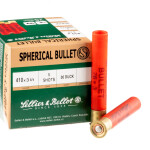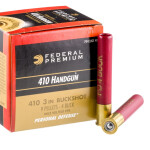-
 25 Rounds of .410 Ammo by Winchester - 11/16 ounce #6 shot
$24.25
25 Rounds of .410 Ammo by Winchester - 11/16 ounce #6 shot
$24.2547 Ready to Ship
-
 20 Rounds of .410 Ammo by Hornady - FTX Slug
$22.50
20 Rounds of .410 Ammo by Hornady - FTX Slug
$22.5053 Ready to Ship
-
 25 Rounds of .410 Ammo by Sellier & Bellot - 00 Buck
$29.50
25 Rounds of .410 Ammo by Sellier & Bellot - 00 Buck
$29.5056 Ready to Ship
-
 20 Rounds of .410 Ammo by Federal - 000 Buck
$23.75
20 Rounds of .410 Ammo by Federal - 000 Buck
$23.7550 Ready to Ship
-
 25 Rounds of .410 Ammo by Sellier & Bellot - 2-1/2" Multi Shot 000 Buck & BB Shot
$30
25 Rounds of .410 Ammo by Sellier & Bellot - 2-1/2" Multi Shot 000 Buck & BB Shot
$3063 Ready to Ship
-
 200 Rounds of .410 3" Ammo by Federal Self Defense - #4 Buckshot
$249
200 Rounds of .410 3" Ammo by Federal Self Defense - #4 Buckshot
$2495 Ready to Ship
-
 200 Rounds of .410 Ammo by Federal - 000 Buck
$254
200 Rounds of .410 Ammo by Federal - 000 Buck
$2542 Ready to Ship
-
 20 Rounds of .410 3" Ammo by Federal - 000 Buck
$26.50
20 Rounds of .410 3" Ammo by Federal - 000 Buck
$26.5065 Ready to Ship
-
 20 Rounds of .410 Ammo by Federal - #4 Buck
$26.50
20 Rounds of .410 Ammo by Federal - #4 Buck
$26.5059 Ready to Ship
-
 20 Rounds of .410 Ammo by Federal - #4 shot
$26.75
20 Rounds of .410 Ammo by Federal - #4 shot
$26.7539 Ready to Ship
-
 25 Rounds of 3" .410 Ammo by Sellier & Bellot - 15 BB Shot - 2 000 Buck Shot
$34.50
25 Rounds of 3" .410 Ammo by Sellier & Bellot - 15 BB Shot - 2 000 Buck Shot
$34.5054 Ready to Ship
-
 250 Rounds of .410 Ammo by Winchester Super-X - 1/4 ounce HP Rifled Slug
$359
250 Rounds of .410 Ammo by Winchester Super-X - 1/4 ounce HP Rifled Slug
$3593 Ready to Ship
-
 250 Rounds of .410 Ammo by Winchester Super-X - 000 Buck
$424
250 Rounds of .410 Ammo by Winchester Super-X - 000 Buck
$4246 Ready to Ship
-
 5 Rounds of .410 Ammo by Winchester Super-X - 1/4 ounce HP Rifled Slug
$8.75
5 Rounds of .410 Ammo by Winchester Super-X - 1/4 ounce HP Rifled Slug
$8.7557 Ready to Ship
-
 5 Rounds of .410 Ammo by Winchester - 1/5 ounce HP Rifled Slug
$8.75
5 Rounds of .410 Ammo by Winchester - 1/5 ounce HP Rifled Slug
$8.7555 Ready to Ship
-
 10 Rounds of .410 PDX1 Ammo by Winchester - 3 Defense Discs over 12 Plated Shot
$19.50
10 Rounds of .410 PDX1 Ammo by Winchester - 3 Defense Discs over 12 Plated Shot
$19.5057 Ready to Ship
-
 250 Rounds of .410 Ammo by Winchester Super-X - 000 Buck
$509
250 Rounds of .410 Ammo by Winchester Super-X - 000 Buck
$5091 Ready to Ship
-
 5 Rounds of .410 Ammo by Winchester Super-X - 000 Buck
$11.25
5 Rounds of .410 Ammo by Winchester Super-X - 000 Buck
$11.2567 Ready to Ship
-
 10 Rounds of .410 Ammo by Winchester Elite - Plated Disc PDX1 Buckshot
$23.50
10 Rounds of .410 Ammo by Winchester Elite - Plated Disc PDX1 Buckshot
$23.5057 Ready to Ship
-
 150 Rounds of .410 3" Ammo by Remington - 000 Buck
$374
150 Rounds of .410 3" Ammo by Remington - 000 Buck
$37416 Ready to Ship
-
 5 Rounds of .410 Ammo by Fiocchi Golden Turkey TSS - 13/16 ounce #9 shot
$38.25
5 Rounds of .410 Ammo by Fiocchi Golden Turkey TSS - 13/16 ounce #9 shot
$38.2529 Ready to Ship
410 Ammo - Common Uses & History
.410 bore shotshells are known for their low recoil and are often used by new shooters or, conversely, those seeking a challenge against small targets. Introduced in the 19th century by British ammo manufacturer Eley, the .410 is named for the nominal diameter of the bore firing it; despite this, it is common for shooters to refer to "410 gauge." Unlike many other shells, .410 bore ammo usually comes in hull lengths of 2-1/2" and 3". Shotguns in this gauge are typically designed for sporting use, while revolvers such as the S&W Governor and Taurus Judge can fire both .45 Colt cartridges and .410 bore shotshells and are intended as self-defense firearms. Certain survival rifles such as the M6 used by the United States Air Force also incorporated a .410 barrel.Typical uses for this gauge include target shooting and hunting; the small payload of the .410 means that it is not overly destructive to meat. Shooters usually take animals such as squirrels and rabbits with the .410 bore, as the relatively small patterns thrown by the shell are not ideal for hitting birds reliably. .410 ammo firing #6 to #9 shot is well suited to these purposes.
While most .410 loads are designed for sporting use and fire birdshot, a few fire relatively large projectiles and are intended for defensive use. Examples of these types of .410 ammo include slugs from Remington and Hornady and a 000 buck load from Federal. In this context, the .410's main advantage is the compactness of the weapon firing it, rather than the cartridge's power.
